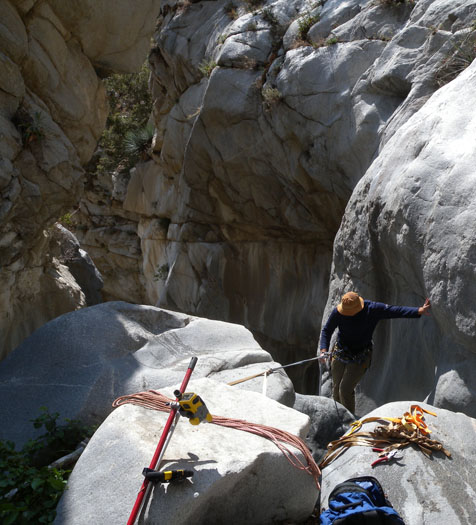Re: Misc. News (Archive)
Posted: Thu Apr 18, 2013 7:30 pm
Speed May Be Cause of Fatal Crash Near Claremont 4/17/13
http://glendora.patch.com/articles/upda ... -claremont
"The 21-year man killed in rollover crash on a rain-slick mountain road near Claremont was identified by today as Kyle Crampton, 32, of Chino Hills....The single-vehicle crash on Mt. Baldy Road at Mountain Avenue was reported around 10:40 p.m. Monday, said California Highway Patrol Officer Patrick Kimball. The victim was pronounced dead at the scene, he said....Light rain and excessive speed were likely factors in the crash, a CHP officer told a news photographer at the scene....The driver was headed downhill without wearing a safety belt and ended up pinned in the badly crumpled car, the photographer reported."
Two airlifted after crashes in OHV area in San Gabriel Mountains 4/14/13
http://www.sgvtribune.com/breakingnews/ ... an-gabriel
http://www.facebook.com/pages/Azusa-Can ... group_id=0

2013 Climb for Heroes @MtBaldy 4/14/13
http://heroes.convio.net/site/TR?fr_id=1040&pg=entry
Beware of Dog: The Little-Known Story of the Poodle-Dog Bush and Its Nasty Bite
http://www.rei.com/share/rei-blog/2013/ ... -bush.html
"...From a safe distance, I got a look at the beast during a recent visit to SoCal. Kerry Johnston, a botanist with the Angeles National Forest (which includes the San Gabriel Mountains and other wild terrain north of Los Angeles), showed me a spot where poodle-dog bush is flourishing. Here’s what I learned:....
REI: What do you know about the plant?
Johnston: The scientific name was recently changed to Eriodictyon parryi. Its old name was Turricula parryi. It is a sub-shrub, meaning it’s not a perennial—it’s not going to complete its lifecycle in 2 years. It’s not going anywhere right now. I’m assuming after the canopy closes and the shrubs start taking over, it will just die back. We’re just watching to see when. When is that going to happen? We work around it all the time, and it makes it difficult getting to all these planting units [where seedlings are being planted to restore the forest] because you’re trying to go around it and avoid it, and it’s made doing that really difficult...."
Paramount ticks test positive for Lyme
http://www.theacorn.com/news/2013-04-18 ... _Lyme.html
".....Paramount Ranch was one of three Santa Monica Mountains park sites that came back positive for Lyme disease in tests conducted by the Los Angeles County West Vector and Vector- Borne Disease Control District. The other two locations were Tapia Park and Malibu Creek State Park, both located within a short distance of one another.Robert Saviskas, executive director of the L.A. county agency responsible for conducting the tests, said this was the first year his agency tested for Lyme disease at Paramount Ranch, among approximately 12 sites tested within the Santa Monica Mountains. The first tick known to carry Lyme disease was found in the mountains in 1998.“We’re finding that about 1 or 2 percent of western blacklegged ticks in the area carry the Lyme disease bacteria, so it’s important for us to identify where the problem is occurring,” Saviskas said. “This particular tick is most active from late November through May.”
Historical from 2009:Of Telescopes and Ticks: How Mount Wilson Observatory Became an Infectious Disease Study Site
http://www.scientificamerican.com/artic ... -mt-wilson
"...Schwan agreed to run a DNA test on the ticks and confirmed that they contained the spirochete Borrelia hermsii. "With the vector and spirochete found in the very room where Larry was exposed," Schwan says, "I was convinced he had contracted relapsing fever."If it was true, Schwan realized, it would be the first new case of relapsing tick fever in Los Angeles County since the 1930s...."
link from article:
http://wwwnc.cdc.gov/eid/article/15/7/0 ... rticle.htm
".....A few vertebrate animals potentially involved with this focus were investigated. Douglas tree squirrels (Tamiasciurus douglasii), which are important hosts for O. hermsi ticks and B. hermsii spirochetes, inhabit the Sierra Nevada Mountains to the north but are absent from the San Gabriel and San Bernardino Mountains (9,24,25). Other sciurids, including the California ground squirrels (S. beecheyi), Western gray squirrels (Sciurus griseus), and Merriam chipmunks (T. merriami), are abundant on the observatory grounds. Several species of mice (Peromyscus spp.) are also found at the observatory. In 1947, Longanecker collected 90 O. hermsi ticks from an active deer mouse nest near Big Bear Lake (26). Many larval and nymphal ticks had recently fed, and some specimens were infected with spirochetes. Our serologic results suggest that brush mice (P. boylii) are involved in the enzootic focus on Mt. Wilson.Western bluebirds (Sialia mexicana) are also abundant around the observatory and nest in tree hole cavities. O. hermsi ticks have been found in bluebird nests in the Sierra Nevada Mountains and in British Columbia, Canada (26,27); these birds may also serve as hosts for the ticks in this site. Further work is needed to determine the role that these and other mammals and birds may play in maintaining the ticks and spirochetes in the mountains of southern California...."
Historical 2010: East Fork San Gabriel River 2010 Summary Report
https://nrm.dfg.ca.gov/FileHandler.ashx ... ntID=40820
A detailed 24 page analysis of fish in the East Fork SG river from Heaton upstream to Prairie Fork.With an average depth less than a foot, the river was calculated at 17 CFS. If you were way off on how many fish you thought were there before reading, I suspect you arent alone.
Fishies from page 12

http://glendora.patch.com/articles/upda ... -claremont
"The 21-year man killed in rollover crash on a rain-slick mountain road near Claremont was identified by today as Kyle Crampton, 32, of Chino Hills....The single-vehicle crash on Mt. Baldy Road at Mountain Avenue was reported around 10:40 p.m. Monday, said California Highway Patrol Officer Patrick Kimball. The victim was pronounced dead at the scene, he said....Light rain and excessive speed were likely factors in the crash, a CHP officer told a news photographer at the scene....The driver was headed downhill without wearing a safety belt and ended up pinned in the badly crumpled car, the photographer reported."
Two airlifted after crashes in OHV area in San Gabriel Mountains 4/14/13
http://www.sgvtribune.com/breakingnews/ ... an-gabriel
Note: This particular day was the off-road finalsANGELES NATIONAL FOREST - Two people were airlifted from the off-highway vehicle area in two separate incidents near San Gabriel Road and East Fork Road in the San Gabriel Mountains on Sunday, officials said.Los Angeles County Firefighter Sean Travis said the patients suffered limb fractures and were airlifted in separate incidents at the same location. Both incidents involved collisions between off-highway vehicles near the water's edge, he said.No further information was available on the condition of the patient
http://www.facebook.com/pages/Azusa-Can ... group_id=0

2013 Climb for Heroes @MtBaldy 4/14/13
http://heroes.convio.net/site/TR?fr_id=1040&pg=entry
Beware of Dog: The Little-Known Story of the Poodle-Dog Bush and Its Nasty Bite
http://www.rei.com/share/rei-blog/2013/ ... -bush.html
"...From a safe distance, I got a look at the beast during a recent visit to SoCal. Kerry Johnston, a botanist with the Angeles National Forest (which includes the San Gabriel Mountains and other wild terrain north of Los Angeles), showed me a spot where poodle-dog bush is flourishing. Here’s what I learned:....
REI: What do you know about the plant?
Johnston: The scientific name was recently changed to Eriodictyon parryi. Its old name was Turricula parryi. It is a sub-shrub, meaning it’s not a perennial—it’s not going to complete its lifecycle in 2 years. It’s not going anywhere right now. I’m assuming after the canopy closes and the shrubs start taking over, it will just die back. We’re just watching to see when. When is that going to happen? We work around it all the time, and it makes it difficult getting to all these planting units [where seedlings are being planted to restore the forest] because you’re trying to go around it and avoid it, and it’s made doing that really difficult...."
Paramount ticks test positive for Lyme
http://www.theacorn.com/news/2013-04-18 ... _Lyme.html
".....Paramount Ranch was one of three Santa Monica Mountains park sites that came back positive for Lyme disease in tests conducted by the Los Angeles County West Vector and Vector- Borne Disease Control District. The other two locations were Tapia Park and Malibu Creek State Park, both located within a short distance of one another.Robert Saviskas, executive director of the L.A. county agency responsible for conducting the tests, said this was the first year his agency tested for Lyme disease at Paramount Ranch, among approximately 12 sites tested within the Santa Monica Mountains. The first tick known to carry Lyme disease was found in the mountains in 1998.“We’re finding that about 1 or 2 percent of western blacklegged ticks in the area carry the Lyme disease bacteria, so it’s important for us to identify where the problem is occurring,” Saviskas said. “This particular tick is most active from late November through May.”
Historical from 2009:Of Telescopes and Ticks: How Mount Wilson Observatory Became an Infectious Disease Study Site
http://www.scientificamerican.com/artic ... -mt-wilson
"...Schwan agreed to run a DNA test on the ticks and confirmed that they contained the spirochete Borrelia hermsii. "With the vector and spirochete found in the very room where Larry was exposed," Schwan says, "I was convinced he had contracted relapsing fever."If it was true, Schwan realized, it would be the first new case of relapsing tick fever in Los Angeles County since the 1930s...."
link from article:
http://wwwnc.cdc.gov/eid/article/15/7/0 ... rticle.htm
".....A few vertebrate animals potentially involved with this focus were investigated. Douglas tree squirrels (Tamiasciurus douglasii), which are important hosts for O. hermsi ticks and B. hermsii spirochetes, inhabit the Sierra Nevada Mountains to the north but are absent from the San Gabriel and San Bernardino Mountains (9,24,25). Other sciurids, including the California ground squirrels (S. beecheyi), Western gray squirrels (Sciurus griseus), and Merriam chipmunks (T. merriami), are abundant on the observatory grounds. Several species of mice (Peromyscus spp.) are also found at the observatory. In 1947, Longanecker collected 90 O. hermsi ticks from an active deer mouse nest near Big Bear Lake (26). Many larval and nymphal ticks had recently fed, and some specimens were infected with spirochetes. Our serologic results suggest that brush mice (P. boylii) are involved in the enzootic focus on Mt. Wilson.Western bluebirds (Sialia mexicana) are also abundant around the observatory and nest in tree hole cavities. O. hermsi ticks have been found in bluebird nests in the Sierra Nevada Mountains and in British Columbia, Canada (26,27); these birds may also serve as hosts for the ticks in this site. Further work is needed to determine the role that these and other mammals and birds may play in maintaining the ticks and spirochetes in the mountains of southern California...."
Historical 2010: East Fork San Gabriel River 2010 Summary Report
https://nrm.dfg.ca.gov/FileHandler.ashx ... ntID=40820
A detailed 24 page analysis of fish in the East Fork SG river from Heaton upstream to Prairie Fork.With an average depth less than a foot, the river was calculated at 17 CFS. If you were way off on how many fish you thought were there before reading, I suspect you arent alone.
Fishies from page 12







